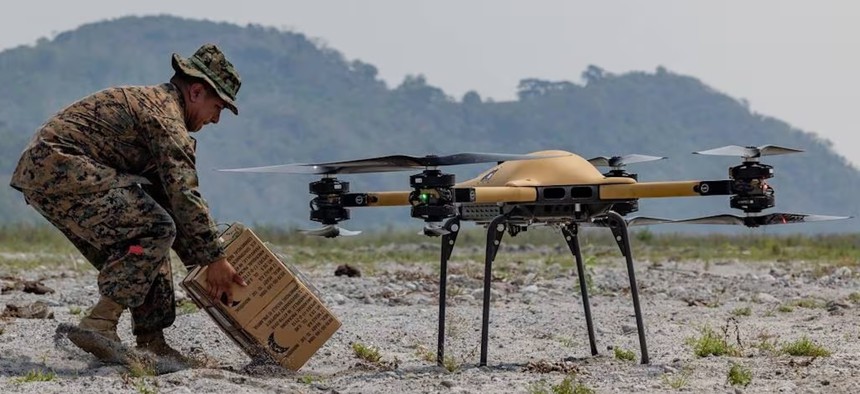
Marines are learning about deconfliction as they work with the TRV-50 Tactical Resupply Unmanned Aircraft System, seen here during Balikatan 23 in Cerab, Philippines. Cpl. Tyler Andrews/Marine Corps
Marine Corps to field squad-level loitering munitions by 2027
The Corps’ experience with logistics drones is yielding valuable lessons on deconflicting with friendly aircraft.
Some Marine Corps squads will get loitering munitions as soon as fiscal year 2027, and the race is already on to figure out how to operate them in congested airspace, two program managers said Tuesday.
The Corps first identified the need for an infantry-controlled loitering munition in 2020, shortly after Azerbaijan used multiple types of one-way attack drones to devastate Armenian forces.
Since then, the Marines have stood up several loitering munitions programs, including one called the Organic Precision Fire program that will provide squad and platoon-sized units with loitering munitions. That program is split into two elements: Organic Precision Fire—Infantry and Organic Precision Fire—Mounted, for use on vehicles.
The Marine Corps is “going pretty aggressively into identifying a lightweight solution for squads,” said Travis Bowden, capabilities integration officer for Organic Precision Fires.
Marines in the field will get the weapon “sometime in [fiscal year] 2027, Bowden said, though the timeline also depends on how well potential suppliers perform.
Use of drones in Ukraine has validated many of the Marine Corps’ assumptions about how to use loitering munitions, Bowden said. Still, he cautioned that the Marines’ global, expeditionary nature means it has different priorities than Ukrainian drone-bombing units with short logistics chains.
For one, fuzes, lithium batteries, and other elements of a loitering munition will have to be stored safely on ships and planes traveling anywhere in the world. The variation in climate from the sweltering Pacific to the freezing Arctic could also affect the munitions’ battery life, he said.
Changing weather could also affect accuracy, Bowden said.
And the jury is still out on whether the service will choose a sophisticated, expensive weapon or a simpler, cheaper model, Bowden said.
“That's why the lessons from Ukraine and other places are giving us some starting points to kind of validate what we're thinking,” he said.
Regardless, given the limitations of weather, electronic warfare, and logistics, Bodwen said he does not foresee loitering munitions “darkening the sky.”
Command and control systems will also need to improve for the Marine Corps to use the weapons, he said, including better intelligence collection for identifying targets and greater communications between units to coordinate strikes.
Targeting, communications, and weapons will need to “progress together and mature together in order to realize that full targeting process that we're trying to get to the lowest level,” of command, he said.
The Marines’ fielding of another drone, the resupply TRV-150C model, is already providing lessons in drone deployment, said Master Sgt. Christopher Genualdi, capabilities integration officer for aerial delivery and autonomous distribution systems.
The Marine Corps announced the initial fielding of six of the large drones in November of last year. The drones are designed to drop-off payloads to Marines deployed in areas where an enemy’s defenses prevent aerial resupply. The drones can fly a payload of 150 pounds about nine miles.
The drones are so easy to fly that they are piloted by members of Marine logistics units, rather than dedicated drone pilots, Genualdi said.
However, as troops learn to use the system, they’ve discovered that there’s no easy way to keep drones out of the way of other U.S. aircraft and airborne munitions.
Units can manually deconflict airspace by verbally informing other units, including Marine aviators, of the drones presence, Genualdi said. Failing that, though, the Marine Corps systems do not easily allow for tracking of both unmanned and manned planes at the same time.
“I have a guy who works in the Direct Air Support Center, deconflicting in the airspace,” he said, “but our systems don't necessarily talk to his.”
Genualdi said the issue isn’t insolvable, pointing to successes in the commercial sector for tracking airborne vehicles.
“I'm able to go online right now and kind of see every single civilian aircraft,” he said.
The Marine Corps is also working through who is supposed to fix the drones when they break.
The current repair program consists of contracted repair, in which drones are sent back to dedicated repair centers. In the field, though, Marines may need to learn how to make simple repairs, like swapping out motors. For example, troops qualified at micro-soldering might step into repair drones, Genualdi said.




